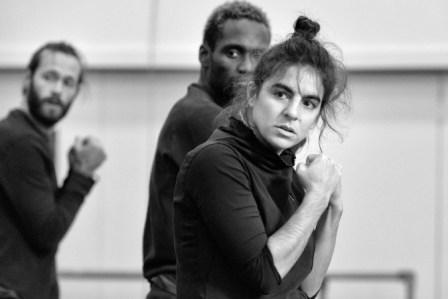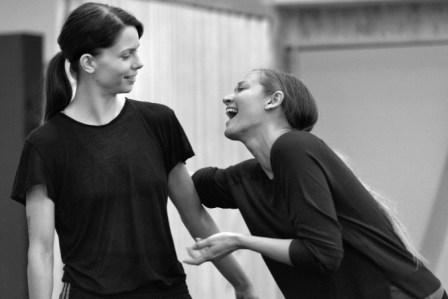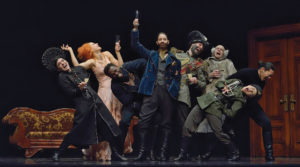Behind the Scenes with Kidd Pivot – Banff Centre’s avant-premiere: Crystal Pite and Jonathon Young’s Revisor - Vancouver Ballet Society
- Home
- Features 2015 - 2019
- Behind the Scenes with Kidd Pivot – Banff Centre’s avant-premiere: Crystal Pite and Jonathon Young’s Revisor

By Kaija Pepper
On the February morning of Revisor’s avant-premiere — set for that evening at Banff Centre’s Eric Harvie Theatre high within Alberta’s Rocky Mountains — it’s minus 26 degrees centigrade when I leave my hotel room. The air grabs at my lungs, sucking moisture from my body, and I walk quickly over to the bistro to meet Eric Beauchesne, the associate artistic director of Kidd Pivot, the company behind the production. He’s agreed to an interview on what is possibly the tensest morning of all for everyone involved in this co-creation between Crystal Pite, Kidd Pivot’s founding director, and Jonathon Young from Electric Company Theatre.
Pite is the celebrated Vancouver-based choreographer known for her magical, inventive creations for Paris Opera Ballet, London’s Royal Ballet and Nederlands Dans Theater, among many others. Betroffenheit, the Kidd Pivot dance-theatre hybrid she co-created with Young, won awards and toured widely around the world. Following hot on the heels of that blockbuster success, Revisor comes with high expectations. Kidd Pivot was at Banff Centre as part of a three-week residency to get the work up on the boards and polished before its official Vancouver premiere a week later. When I ask Beauchesne how the dancers have been coping in the high altitude, he says it took the first week to get acclimatized. “But it’s good,” he says, “it’s like Olympic training.” Once you master dancing on the mountain, “you’re like a rock star on the plain!”
He adds, “We have pretty much the entire team here to finish the piece. It’s also pretty much the same team we had for Betroffenheit. We’re like a family, we understand each other, which means you don’t lose time learning how people will work together.”
Collegial dynamics are something he negotiates constantly through his involvement in a range of activities that seem to intersect with everyone on the creative and production teams. Although he acts as rehearsal director on tour whenever Pite is busy with another project, “right now, Crystal is really hands-on with the dancers, so I might clean some sections a little, but most of my work is assisting her.”
Beauchesne danced with Kidd Pivot for 10 years; his last onstage role was the dramatically weighty father figure, Prospero, in Pite’s Tempest Replica. This means he has a lot of firsthand physical knowledge about Pite’s choreographic vocabulary. “I’ve probably developed more instinct than I’m even aware of,” he says.
Beauchesne’s daily schedule is multi-faceted, including attending rehearsals where he films run-throughs and takes notes for Pite. “Afterward, Crystal and I will have a two- or three-minute chat about the next day, to talk about priorities, and what I should share with the dancers or collaborators. I also brief her about a bunch of things.” He compares his job to that of a curler, frantically sweeping the ice to clear the path of anything that might impede the stone as it approaches its target. “I need to think ahead to what Crystal might need in 10 minutes or even five seconds!”
He’s in close touch with the dancers, too. Four of the eight who perform in Revisor are new to Kidd Pivot, and there’s one swing, Renée Sigouin, who must be ready to fill in when needed. Revisor comes with challenges even for the most experienced Kidd Pivot dancer, says Beauchesne, because with the other shows behind them they are hyper-aware of the myriad angles and subtleties possible for them to tap into. Plus, he adds, “The roles in Revisor are epic, emotionally and physically.”
The 80-minute work is built around a script by Young, inspired by playwright Nikolai Gogol’s farce, The Inspector General. Pite, as director and choreographer, is working with the script in several complex ways, including sections where the dancers move expressively in tight relationship to the dialogue.
“Crystal did a bit of that in Betroffenheit,” says Beauchesne, “where the body would move exactly on the text. It was like the text was almost possessing the body.” As with lip sync, if the movement is behind by even a fraction of a second, “it looks wrong.”
Each dancer is matched with an actor who is the voice for their character; the voiceovers were recorded last summer and are now layered with music, typically with several tracks playing at the same time.

Photo: Michael Slobodian
“Yesterday morning, I uploaded the newest versions to the dancers so they could listen to them on their phones before our dress rehearsal,” says Beauchesne. Changes this late in the day for such a complex orchestration of sound and vision are, he admits, “very nerve-wracking.”
A few minutes before 10 a.m., Beauchesne leaves for the theatre to assist Pite, with light and sound cues as the main agenda. I head down the mountain to the small resort town of Banff, a short walk away, returning that afternoon to catch some of the rehearsal with the dancers. As I shuffle into the dark auditorium, they are in action onstage. Once my eyes adjust, I can see Pite sitting at the back of the auditorium alongside technical crew and lighting and sound designers, a whole row of their computer screens glowing. Young is sitting alone several rows down.
“We’re going to build a new little scene,” Pite announces quietly before running down the aisle and climbing onto the stage. Her manner is low-key as she works with the dancers, but there is dogged determination as, over and over, she asks, “Can we try it one more time?”
Each run-through involves a team effort because the dancers’ movement is so closely integrated with sound, lighting and scenic design. As Beauchesne says, “The way things are put together — the mise-en-scène — gives a real depth of meaning” to the choreography. Clearly, having the actual theatre space in which to rehearse for the last two weeks has been invaluable. At 3.15 p.m., a new music track arrives from one of Revisor’s composers and sound designers (there are three in the double role: Owen Belton, Alessandro Juliani and Meg Roe). Once it’s confirmed the material is in the system, Pite announces yet another “one more time.” Just hours before the audience arrives, the theatre is not yet a place to dream, as action explodes in spurts and starts, the stage going to dark and coming to light again and again.
The dancers are in rehearsal clothes, but I’ve been told that character-rich costumes are part of the finely calibrated web of design supporting their performances. I had hoped to talk to costume designer Nancy Bryant, but she begged off until the next day.

Photo: Michael Slobodian
That night, as the audience streams into the theatre, there is the usual sense of anticipation that precedes any new work. As Revisor’s opening scene begins, the hush is intense. The familiar themes of the Gogol farce, in which corrupt and inept officials from “the centre” are shaken up by the arrival of an underling they mistake for a high-level inspector, play out.
The story is told with those stunning integrations of movement and text we have come to expect from Pite’s work with her own company, now in collaboration with Young. As the dancers physically express the emotions and intentions, the text and subtext, the truths and lies of their eccentric characters, the audience chuckles at all the right places.
The next day, the atmosphere has notably lightened. When I visit the costume department in the basement of the theatre complex, Bryant is chatting quietly with Stevie Hale Jones (wig and wardrobe co-ordinator) and Elena Vandakurova (Banff Centre’s wardrobe maintenance technician). They’re discussing small fixes and tweaks Bryant has on the day’s to-do list: a belt needs attaching to some pants, a top needs to be dyed a lighter shade and a headpiece needs adjusting. The headpiece is key to the hilarious transformation of dancer j into a bent, bushy-browed old man, complete with mutton-chop sideburns; it lays on a nearby table, its bald top frankly and comically false. “I’m going to move the eyebrows up,” explains Bryant, “because they’re covering David’s eyes too much.”
In addition to creative vision, costume design for dance involves great practical forethought. Bryant says that adding large gussets in the underarms ensures arms can be freely and fully extended, and that acetate lining makes the sleeves slippery and easy to get into during quick costume changes.
“There’s a lot of bribing with wads of bills that have to be stuffed into pockets, so some of the coats have slits on the side to help the dancers access their pant pockets easily,” she says.
There are extra deep pockets in the trousers for the title character of the Revisor, a dandy who receives numerous bribes; he’s the underling, a mere reviser of legal documents, mistaken for an important government inspector. Performed by Tiffany Tregarthen (to a voiceover by Young), the role is another hilarious transformation, this time of gender as well as personality.
Bryant, like many on Revisor’s creative team, has had a long working relationship with Pite. Hers goes back to 1996 and the costume design for the domestic drama, Moving Day, which Pite made for Ballet BC just before she left that company to dance with Frankfurt Ballet. As Beauchesne puts it, the team is like a family. And they have history together.
Pite’s real-life family also made the journey to Banff Centre — her husband Jay Gower Taylor, a scenic designer who devised the set for many of her works, including Revisor, and their young son.
When I run into Gower Taylor in the lobby before the performance on the second night, he explains the technology he came up with for the light paintings that are a major visual element of the piece. It involves Mylar and two spotlights high up in the flies behind a rear projection screen. Revisor’s action is conventionally framed by a few realistic set pieces, including a desk, a chair and a doorway, while the icy shards of light on the backdrop seem to support the poetic, more ephemeral aspects that are so crucial to Pite’s aesthetic.
After the bell sounds a five-minute warning, we follow the crowd into the auditorium. Gower Taylor sits near the front with several colleagues. Pite joins them just before the lights go down, slipping into an aisle seat. Although I’m near the front as well, once the show starts I never even think to look for any of the small changes that had been fussed over after opening night.
It’s not that they are unimportant, but I want to do my thing as a critic and member of the audience, unencumbered with practical or technical backstory. I immerse myself in the art that rushes past onstage, allowing Revisor to reveal itself through the unfolding of its uniquely imaginative choreographic and theatrical vision.

